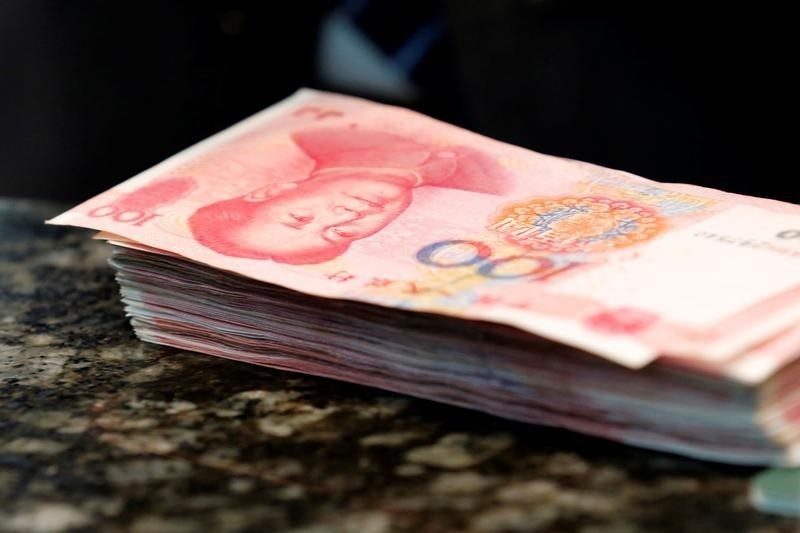By Kevin Yao, Nathaniel Taplin and Lu Jianxin
BEIJING/SHANGHAI (Reuters) - China's central bank would tolerate a fall in the yuan to as low as 6.8 per dollar in 2016 to support the economy, which would mean the currency matching last year's record decline of 4.5 percent, policy sources said.
The yuan is already trading at its lowest level in more than five years, so the central bank would ensure any decline is gradual for fear of triggering capital outflows and criticism from trading partners such as the United States, said government economists and advisers involved in regular policy discussions.
Presumptive U.S. Republican Presidential nominee Donald Trump already has China in his sights, saying on Wednesday he would label China a currency manipulator if elected in November.
The economists and advisers are not directly briefed on policy by the People's Bank of China (PBOC), but they have regular meetings and interactions with central bank officials and they provide policy recommendations. They said the central bank would tolerate a further weakening of the yuan this year to between 6.7-6.8 per dollar.
"The central bank is willing to see yuan depreciation, as long as depreciation expectations are under control," said a government economist, who requested anonymity due to the sensitivity of the matter.
"The Brexit vote was a big shock. The market volatility may last for some time."
Investors keep a close watch when the yuan is in decline. A surprise devaluation of the yuan last August sent global markets into a spin on worries the world's second-biggest economy was in worst shape than Beijing had let on, prompting massive capital outflows as investors sought safe havens overseas.
Other emerging market currencies have also fallen in the wake of Britain's vote to leave the European Union, but the yuan is the weakest major Asian currency against the dollar this year.
Following the Reuters report, the yuan
At the low, the yuan had fallen about 2.4 percent this year.
After the report, the PBOC said China had no intention to promote trade competitiveness through depreciation of the yuan, a comment that has also been made repeatedly by Chinese Premier Li Keqiang.
Without citing any media by name, it said on its website that some media continuously published "inaccurate information" on the yuan's exchange rate. These reports interrupt the normal operation of the market and help "speculative forces" short - or bet against - the yuan, it said.
TRADE RELATIONS
Currency dealers said the dollar's strength and weakness in China's economic growth, which hit a 25-year low in 2015, justified a decline in the yuan.
But a significant decline is likely to leave investors and trading partners concerned in the wake of August's devaluation and another sharp decline in the currency over a matter of days in January, which analysts said was engineered by the central bank.
In the past decade, China has also faced criticism from Western lawmakers who say it held back the appreciation of the yuan.
Earlier this month, U.S. Treasury Secretary Jack Lew said it would be "problematic" if the yuan only went down over time and Trump has said he would take a hard line on trade disputes with China if elected.
Labeling China a currency manipulator "should've been done a long time ago," he said on Wednesday.
China's Foreign Ministry said on Wednesday the exchange rate was not the reason for unbalanced trade with the United States, which runs a goods and services trade deficit with China.
However, the sources acknowledged the diplomatic risks of a steep fall in the yuan.
"The pressure from the United States could rise if China allows sharp depreciation," said a government source.
China has the biggest global exports market share of any country since the United States in 1968, so the yuan's exchange rate acts as a bellwether for other exporting countries.
While a South Korean finance ministry official said "we are concerned" about the yuan's slide, a person familiar with Japan's currency diplomacy said the yuan's decline didn't seem out of line considering the dollar's strength.
"I don't think Japan has much to complain about," this official said.
The officials of these major exporters declined to be identified given the sensitivity of the issue.
MARKET FORCES
"We should gradually let market forces play a bigger role. The market believes that the yuan is under pressure, so our foreign exchange policy should follow this trend," said a researcher with the Commerce Ministry.
"China needs to safeguard its economic growth and trade but also make sure we don't create competitive devaluation."
Julian Evans-Pritchard, China economist at Capital Economics, said in a note last week that a sharp fall "could set off a renewed bout of fears over renminbi depreciation and a pick-up in capital outflows." The yuan is also known as the renminbi.
But he said the central bank would want to avoid "panic" so was likely to intervene to stabilize the currency if need be.
The PBOC has been trying to reform the way it manages the yuan by making it more market-driven and transparent.
It sets the yuan's daily mid-point versus the dollar based on the previous day's closing price, taking into account changes in major currencies, analysts and officials said.
This year, the PBOC has been guiding the yuan lower by pegging it to the dollar when the U.S. currency weakens and pegging it to a basket of currencies when the dollar rises, they said.
The currency regime gives the central bank more room to allow two-way swings in the yuan versus the dollar, deterring one-way bets on the currency.

The CFETS RMB Index, a trade-weighted exchange rate index that was unveiled by the central bank in December, fell 5.6 pct between the end of 2015 and June 24 of this year, although the central bank has pledged to keep the yuan basically stable against the basket.